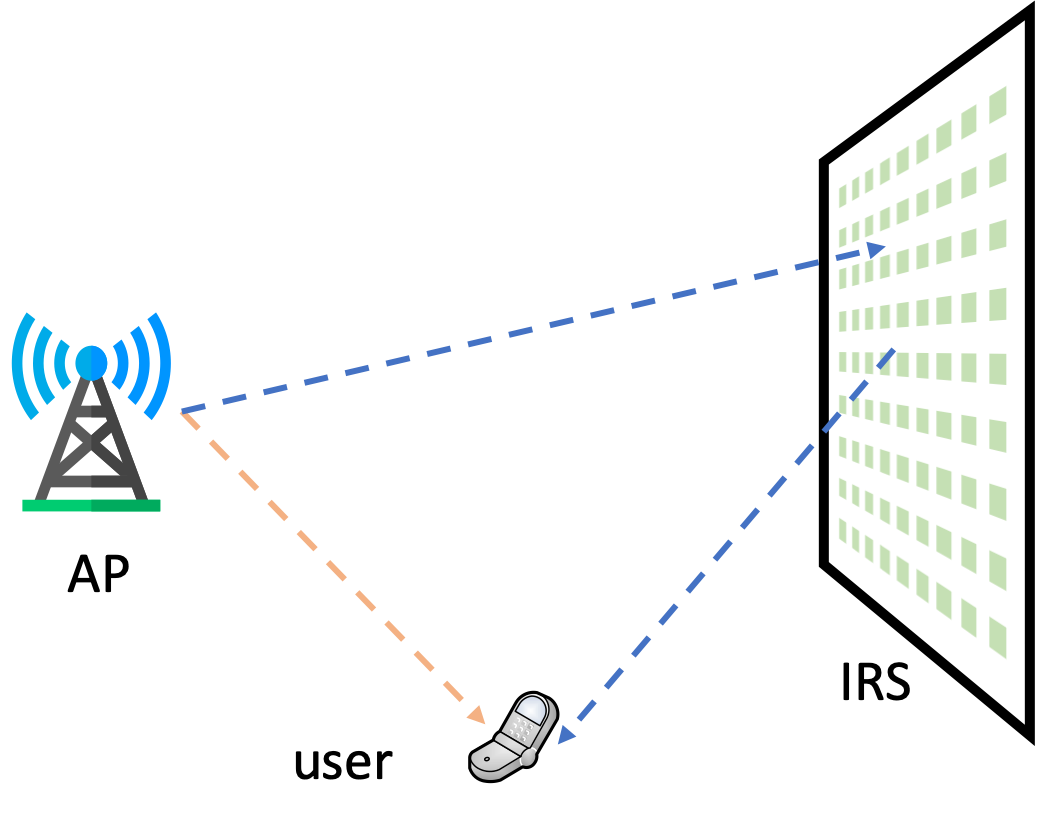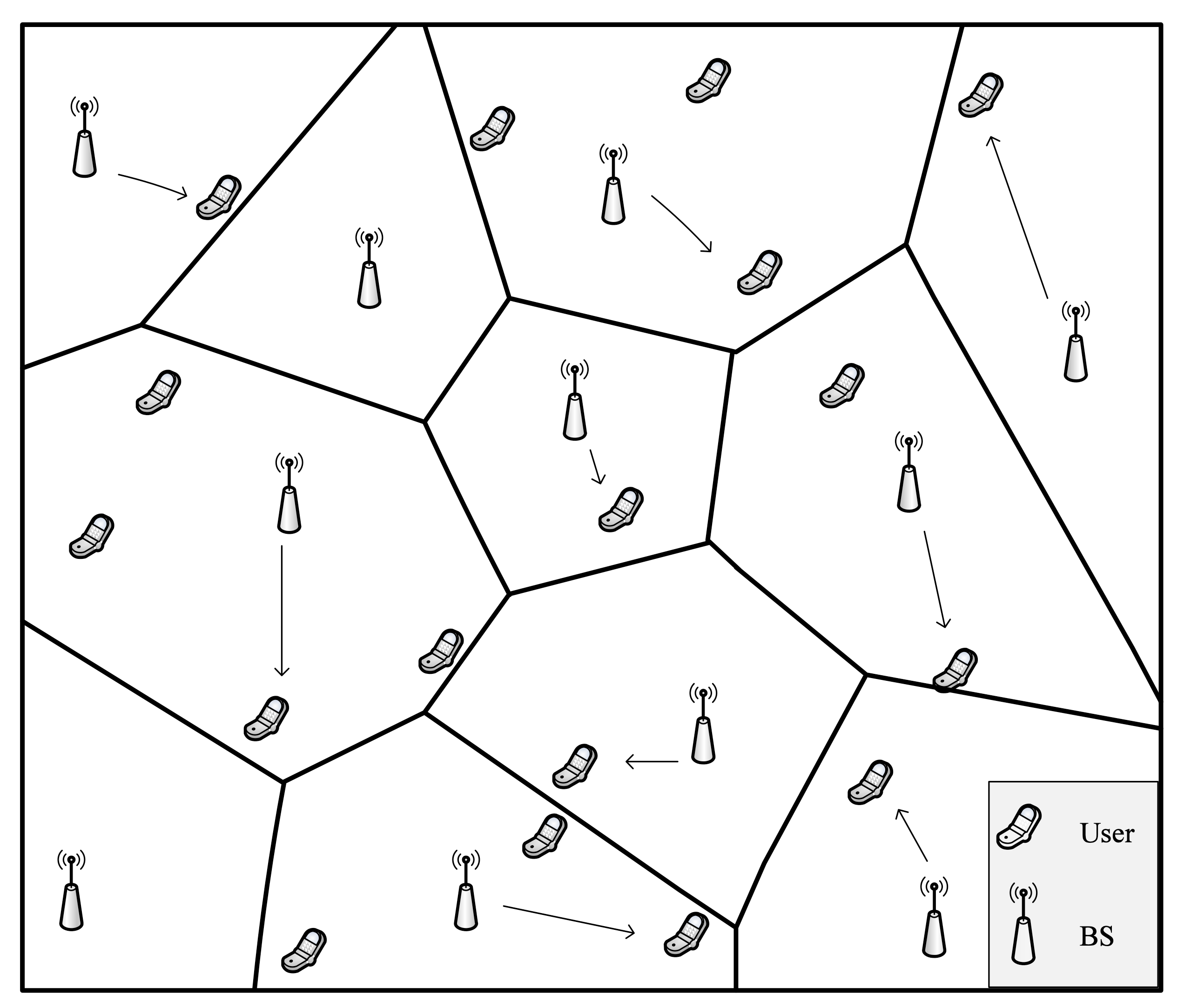Research Interests
Wireless Communications via Intelligent Reflecting Surfaces
 |
Recent advances in electromagnetic (EM) metasurfaces enable the manipulation of the impinging EM waves, which creates the possibility of controlling the wireless channel. Intelligent reflecting surfaces (IRSs), as a kind of passive metasurfaces, have been incorporated in wireless communications systems in recent years. In particular, IRSs are able to change the signal transmission direction with low-cost passive devices, e.g., printed dipoles and phase shifters, which is a revolutionary new characteristic that is not leveraged in conventional wireless communications systems. In this way, IRSs are able to create favorable wireless propagation environments without consuming power. Furthermore, IRSs can be readily coated on the facades of buildings, which reduces implementation cost and complexity. To fully exploit the potential of energy-efficient IRSs, they have to be properly designed and integrated with conventional communication techniques. |
Y. Ma, Y. Shen, X. Yu, J. Zhang, S.H. Song, and K. B. Letaief, “A low-complexity algorithmic framework for large-scale IRS-assisted wireless systems,” submitted to IEEE Global Commun. Conf. Wkshps. (GLOBECOM Wkshps), Taiwan, Dec. 2020. [Paper]
X. Yu, D. Xu, Y. Sun, D. W. K. Ng, and R. Schober, “Power-efficient resource allocation for multiuser MISO systems via intelligent reflecting surfaces,” in Proc. IEEE Global Commun. Conf. (GLOBECOM), Taiwan, Dec. 2020. [Paper]
T. Lin, X. Yu, Y. Zhu, and R. Schober, “Channel estimation for intelligent reflecting surface-assisted millimeter wave MIMO systems,” in Proc. IEEE Global Commun. Conf. (GLOBECOM), Taiwan, Dec. 2020. [Paper]
D. Xu, X. Yu, Y. Sun, D. W. K. Ng, and R. Schober, “Resource allocation for IRS-assisted full-duplex cognitive radio systems,” accepted to IEEE Trans. Commun., Aug. 2020. [Paper]
D. Xu, X. Yu, and R. Schober, “Resource allocation for intelligent reflecting surface-assisted cognitive radio networks,” in Proc. IEEE Int. Workshop Signal Process. Adv. Wireless Commun. (SPAWC), Atlanta, GA, USA, May 2020, pp. 1-5. (Invited Paper) [Paper]
X. Yu, D. Xu, and R. Schober, “Optimal beamforming for MISO communications via intelligent reflecting surfaces,” in Proc. IEEE Int. Workshop Signal Process. Adv. Wireless Commun. (SPAWC), Atlanta, GA, USA, May 2020, pp. 1-5. (Invited Paper) [Paper]
X. Yu, D. Xu, Y. Sun, D. W. K. Ng, and R. Schober, “Robust and secure wireless communications via intelligent reflecting surfaces,” accepted to IEEE J. Sel. Areas Commun., Special Issue on Wireless Networks Empowered by Reconfigurable Intelligent Surfaces, to appear. [Paper]
D. Xu, X. Yu, and R. Schober, “Resource allocation for secure IRS-assisted multiuser MISO systems,” in Proc. IEEE Global Commun. Conf. Wkshps. (GLOBECOM Wkshps), Waikoloa, HI, USA, Dec. 2019. [Paper]
X. Yu, D. Xu, and R. Schober, “Enabling secure wireless communications via intelligent reflecting surfaces,” in Proc. IEEE Global Commun. Conf. (GLOBECOM), Waikoloa, HI, USA, Dec. 2019. (Best Paper Award) [Paper]
X. Yu, D. Xu, and R. Schober, “MISO wireless communication systems via intelligent reflecting surfaces,” in Proc. IEEE/CIC Int. Conf. Commun. China (ICCC), Changchun, China, Aug. 2019, pp. 735-740. (Invited Paper) [Paper]
Hybrid Precoding/Beamforming in Millimeter-Wave MIMO Systems
 |
The spectrum crunch in current cellular systems brings a fundamental bottleneck for the further capacity increase. Millimeter wave (mm-wave) bands have now been put forward as a prime candidate for new spectrum in 5G cellular systems, with the potential bandwidth reaching 10 GHz. For traditional MIMO systems, precoding is typically accomplished at baseband through digital precoders, which can adjust both the magnitude and phase of signals. However, fully digital precoding demands radio frequency (RF) chains, including signal mixers and analog-to-digital converters, comparable in number to the antenna elements. While the small wavelengths of mm-wave frequencies facilitate the use of a large number of antenna elements, the prohibitive cost and power consumption of RF chains make digital precoding infeasible. Given such unique constraints in mm-wave MIMO systems, a hybrid precoding architecture has recently received much consideration, which only requires a small number of RF chains interfacing between a low-dimensional digital precoder and a high-dimensional analog precoder.
J. Zhang, X. Yu, and K. B. Letaief, “Hybrid beamforming for 5G and beyond millimeter-wave systems: A holistic view,” IEEE Open J. Commun. Soc., vol. 1, pp. 77-91, Dec. 2019. (Invited Paper) [Paper]
X. Yu, J. Zhang, and K. B. Letaief, “Doubling phase shifters for efficient hybrid precoding in millimeter-wave multiuser OFDM systems,” J. Commun. Inf. Netw., vol. 4, no. 2, pp. 51-67, July 2019. [Paper]
X. Yu, J. Zhang, and K. B. Letaief, “A hardware-efficient analog network structure for hybrid precoding in millimeter wave systems,” IEEE J. Sel. Topics Signal Process., Special Issue on Hybrid Analog-Digital Signal Processing for Hardware-Efficient Large Scale Antenna Arrays, vol. 12, no. 2, pp. 282-297, May 2018. [Paper] [Codes]
X. Yu, J. Zhang, and K. B. Letaief, “Hybrid precoding in millimeter wave systems: How many phase shifters are needed?” in Proc. IEEE Global Commun. Conf. (GLOBECOM), Singapore, Dec. 2017, pp. 1-6. (Best Paper Award) [Paper]
X. Yu, J. Zhang, and K. B. Letaief, “Partially-connected hybrid precoding in mm-wave systems with dynamic phase shifter networks,” in Proc. IEEE Int. Wkshp. Signal Process. Adv. Wireless Commun. (SPAWC), Sapporo, Japan, July 2017, pp. 129-133.
X. Yu, J. Zhang, and K. B. Letaief, “Alternating minimization for hybrid precoding in multiuser OFDM mmWave Systems,” in Proc. 50th Asilomar Conf. on Signals, Systems, Computers, Pacific Grove, CA, USA, Nov. 2016, pp. 281-285. (Invited Paper) [Paper]
X. Yu, J.-C. Shen, J. Zhang, and K. B. Letaief, “Alternating minimization algorithms for hybrid precoding in millimeter wave MIMO systems,” IEEE J. Sel. Topics Signal Process., Special Issue on Signal Processing for Millimeter Wave Wireless Communications, vol. 10, no. 3, pp. 485-500, Apr. 2016. (2018 IEEE Signal Processing Society Young Author Best Paper Award) (ESI Highly Cited Paper) (Top 25 downloaded article in 2019) [Paper] [Codes]
X. Yu, J.-C. Shen, J. Zhang, and K. B. Letaief, “Hybrid precoding design in millimeter wave MIMO systems: An alternating minimization approach,” in Proc. IEEE Global Commun. Conf. (GLOBECOM), San Diego, CA, USA, Dec. 2015, pp. 1-6.
Stochastic Geometry Analysis of Wireless Networks
 |
Besides increasing the carrier frequency, the other two main approaches to boosting the network capacity is to deploy multiple antennas for achieving high spectral efficiency and to deploy more access points per unit area in the network. It is crucial and intriguing to investigate and characterize the performance of multi-antenna wireless networks. As field trials are costly and system-level simulations are time-consuming, an effective alternative is to evaluate the network performance analytically with the assistance of a mathematical model. Stochastic geometry, especially point process theory, has recently been applied to wireless networks to model the spatial distribution of the transceivers. Based on results derived with the help of stochastic geometry, abundant system insights can be obtained analytically, and provide critical guidance for network deployment, management, and optimization. |
X. Yu, C. Li, J. Zhang, and K. B. Letaief, Stochastic Geometry Analysis of Multi-Antenna Wireless Networks, Springer, 2019. [Book Website]
X. Yu, J. Zhang, R. Schober, and K. B. Letaief, “A tractable framework for coverage analysis of cellular-connected UAV networks,” in Proc. IEEE Int. Conf. Commun. Wkshps. (ICC Wkshps), Shanghai, China, May 2019, pp. 1-6.
X. Yu, C. Li, J. Zhang, M. Haenggi, and K. B. Letaief, “A unified framework for the tractable analysis of multi-antenna wireless networks,” IEEE Trans. Commun., vol. 17, no. 12, pp. 7965-7980, Dec. 2018, pp. 1-6. [Paper]
X. Yu, J. Zhang, M. Haenggi, and K. B. Letaief, “Coverage analysis for millimeter wave networks: The impact of directional antenna arrays,” IEEE J. Sel. Areas Commun., Special Issue on Millimeter Wave Communications for Future Mobile Networks, vol. 35, no. 7, pp. 1498-1512, July 2017. [Paper]
X. Yu, C. Li, J. Zhang, and K. B. Letaief, “A tractable framework for performance analysis of dense multi-antenna networks,” in Proc. IEEE Int. Conf. Commun. (ICC), Paris, France, May 2017, pp. 1-6.
X. Yu, J. Zhang, and K. B. Letaief, “Coverage analysis for dense millimeter wave cellular networks: The impact of array size,” in Proc. IEEE Wireless Commun. Netw. Conf. (WCNC), Doha, Qatar, Apr. 2016, pp. 1-6.